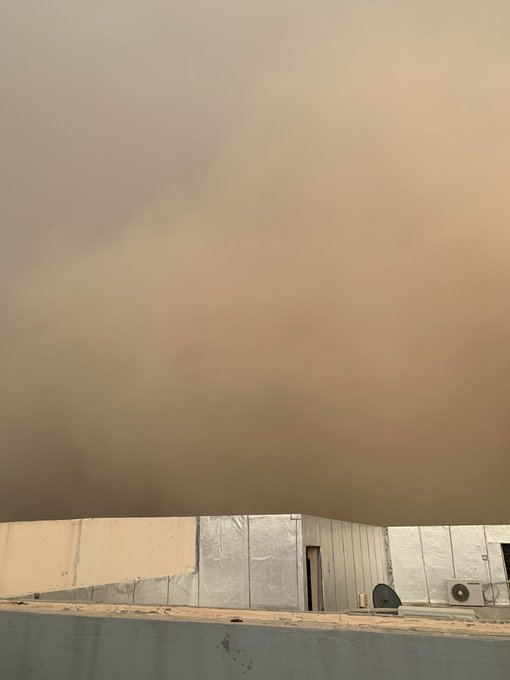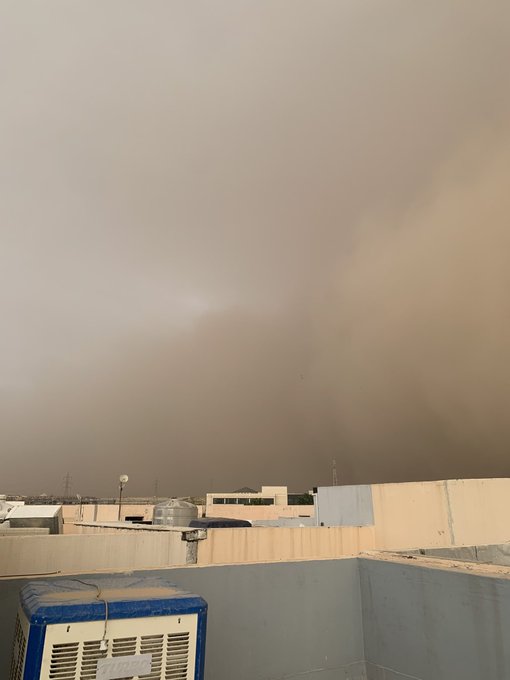Iraqi health workers have recorded over 2,000 cases of “suffocation” as yet another intense dust storm battered the country on Saturday.
The latest storm again grounded flights at the international airports in Erbil, Baghdad, and Najaf due to poor visibility, the country’s aviation officials announced on Saturday.
The 2,250 patients were affected by the dusty condition to various degrees, the Ministry of Health announced in a statement on Sunday.
This is the 12th such dust storm to blanket Iraq this year.
Simona Foltyn:
The marshes only span 2,000 square miles today, a 75 percent reduction compared to their original size.
This is what the marshlands increasingly look like – cracked soil, and bone dry reeds. And even though we're now in November, which is supposed to be the onset of the rainy season, water levels continue to decline. Life here is simply no longer sustainable.
More than half the households here have lost cattle this year due to lack of water, according to a survey carried out by the Norwegian Refugee Council. Dhuhriya Saquir and her family used to keep 20 water buffalos, but that number has dropped to four over the past few years. Their animals refuse to drink the polluted water, which means herders like Dhuriya are forced to buy drinking water to keep them alive.
Dhuhriya Saquir, buffalo herder: Taking care of the buffalos is really making us tired. They are not coming back to us. We go looking for them, but even the boat cannot float after them anymore because there's no water. Then we find them dead, stuck in the mud.
Simona Foltyn:
Temperatures in Iraq have risen by more than 2.5 degrees Celsius since the end of the nineteenth century. That's 4.5 degrees Fahrenheit, double the global average. Projections are equally alarming. says the World Bank's Special Representative for Iraq, Ramzi Neman.
Ramzi Neman, Special Representative in Iraq, World Bank: We expected that an increase in temperature of almost 1.5 degrees within the coming years and that would have a tremendous effect .
Simona Foltyn:
But while Iraq is reeling from the impact of climate change, it is also a significant contributor to the greenhouse emissions that cause global warming. Iraq is the world's sixth largest oil producer, but is second only to Russia in gas flaring, a wasteful process of burning natural gas during oil extraction. Flaring emits CO2 and methane into the atmosphere, and accounts for 15 percent of Iraq's total greenhouse emissions.
The government has vowed to eliminate flaring by 2027. At a recent roundtable with journalists, Iraq's oil minister said the country has allocated over five billion U.S. dollars for gas capture projects.
Although not a new phenomenon in the region, Iraq has faced an unprecedented number of dust and sandstorms since the beginning of this millennium. A few decades ago, Iraq would experience a storm or two a year during the winter season. However, this year, Iraq has already surpassed ten sandstorms during the past two months alone.
These meteorological events, which typically last three to five hours and can reach heights up to five thousand feet, are a hindrance to the average Iraqi civilian. These storms cause many to stay indoors for the duration of the event, followed by countless hours of cleaning as the grains of sand travel into even garment drawers. At times, the settling of the dust and sand particles can last for days. However, these dust and sandstorms have a more dire effect on the nation as a whole, including government and military operations. This piece will examine what is causing the increase of dust and sandstorms in Iraq, the socio-economic costs, and what actions can be taken to mitigate and potentially eliminate them.
Storms on the horizon
The storms cause fatalities around the country and long-term respiratory illnesses by inhaling sand and dust. This year, over ten thousand people were hospitalized, with at least five recorded deaths from the sandstorms that swept through Iraq. As a result of these dire conditions, this year, the Iraqi government shut down for many ministerial and provincial workers. The sandstorms even temporarily suspended all flights into the affected regions in Iraq, including the capital, Baghdad. These sandstorms are viewed as an aviation nightmare, as they drastically decrease the visibility for commercial and military pilots, often grounding all flights as the storm passes.
There appear to be no studies on the economic cost of dust and sandstorms in Iraq; however, a few have been conducted on the Middle East and North Africa (MENA) region that put a dollar figure on the cost. The World Bank did the most comprehensive study in 2019, which found that the economic cost of premature deaths caused by sand and dust inhalation increased by 123 percent between 1990 and 2013 to $141 billion. The report explains that, in 2013, Iraq suffered 10,400 premature deaths due to dust in the air, which cost the economy almost $15 billion, or 3 percent of the year’s gross domestic product. The 2019 World Bank study estimates direct costs from grounded flights, lost crops, and production halted by government-ordered holidays at $13 billion, bringing the MENA region’s total economic cost from dust and sandstorms to over $154 billion annually.
Due to the inaction of the Iraqi government and civil society, the Environment Ministry stated in April that, over the past two decades, dusty days in Iraq have increased from 243 to 272 days per year, and warned that they are expected to reach three hundred days per year by 2050. Iraq is currently experiencing dust and sandstorms throughout all seasons of the year due to climate change, regional drought, desertification, and a decrease in water reserves—all factors that have led to dust accumulation. Studies have found that as much as 71 percent of agricultural land in the once “Fertile Crescent” is threatened by desertification due to climate change, which is decreasing the vegetation cover—the main factor for soil stabilization. According to a 2019 report by the United Nations Environment Programme (UNEP), Iraq is the fifth-most vulnerable nation in the world to the effects of climate change.
Additionally, Iraqi officials claim that water reserves in Iraq have decreased over 50 percent over the past year due to poor rainfall and the water levels of the Tigris and Euphrates Rivers, which account for 98 percent of Iraq’s water reserves combined. The rivers are currently expected to dry up by 2040 if no actions are taken due to lower water levels and climate change.
The Tigris and Euphrates Rivers originate in Turkey and flow to the Shatt al-Arab Basin in Iraq, while the Euphrates crosses through Syria before flowing to Iraq. Due to the Iraqi government’s inaction, plans by Turkey that alter river flows are major contributing factors to the drying up in Iraq. The Turkish government, which is constructing hydropower plants on the banks of the rivers, boasts that their plans are an abundant source of carbon-free electricity. However, experts warn that the dam is taking a human and environmental toll. This, alongside the lack of rainfall, which is decreasing vegetation cover, makes Iraq vulnerable to the microbursts of winds, expanding dust and sandstorms.
It is a damning refutation of Israel’s preposterous lie about her murder, including that she was shot by Palestinians firing indiscriminately at its troops.
Spokeswoman Ravina Shamdasani told reporters Friday, “All information we have gathered … is consistent with the finding that the shots that killed Abu Akleh and injured her colleague Ali Sammoudi came from Israeli security forces and not from indiscriminate firing by armed Palestinians” and that there was no evidence of “activity by armed Palestinians in the immediate vicinity of the journalists.”
The killing on May 11 of Al-Jazeera Arabic’s widely respected veteran journalist, a US-Palestinian citizen, by Israeli forces while she was covering an army raid on Jenin in the occupied West Bank, caused mass outrage. Clad in a press vest and helmet and standing in open view near a roundabout, she was targeted and shot by Israeli snipers along with her co-producer Ali Sammoudi who was hospitalised.
It was a brazen attempt to intimidate and prevent journalists reporting on Israel’s brutal suppression of the Palestinians. According to the Palestinian Center for Development and Media Freedoms, Israeli troops have killed 30 journalists in the West Bank and Gaza Strip since 2000. In each case, there have been no indictments against the soldiers responsible, testifying to the degree to which US backing guarantees impunity.
Israeli police later stormed her family’s home demanding the mourners take down the Palestinian flags and end the gathering and singing. On the day of the funeral, the police gave the pall bearers such a beating that they nearly dropped the coffin. Soldiers fired sponge-tipped bullets and threw stun grenades at the crowds gathered at the hospital morgue until Abu Akleh’s family were forced to whisk her coffin away in a car as a police officer removed the Palestinian flags covering it.


